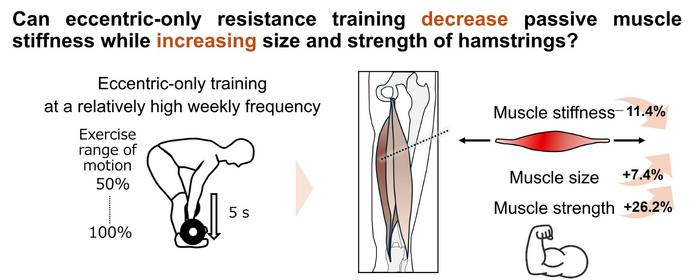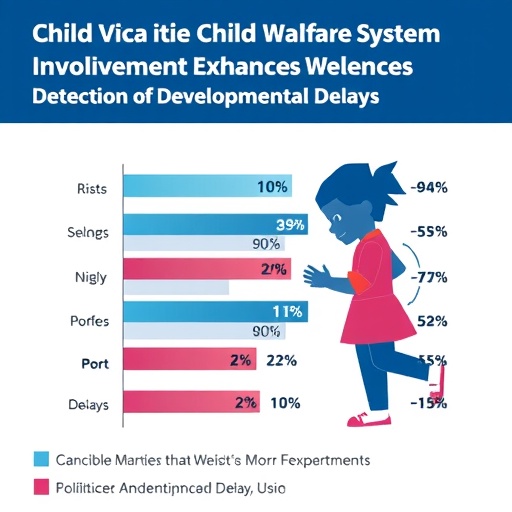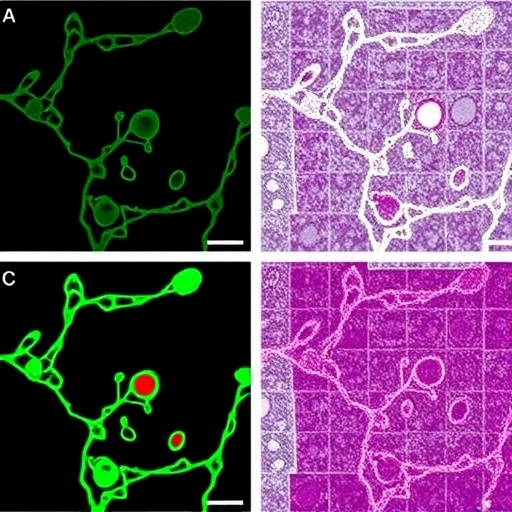Resistance, or weight training, is widely recommended in sports and rehabilitation as an effective exercise to increase muscular strength and size. This form of exercise involves applying resistance to muscle contraction to build strength. However, some practitioners believe resistance training can increase passive muscle stiffness over time. Passive muscle stiffness is a key indicator of how muscles behave mechanically when they are stretched without active contraction. Specifically, it refers to the amount of force required to change the muscle length by a given amount during passive stretching. Studies have shown that high passive stiffness increases the risk of muscular and skeletal injuries and can lower athletic performance in sports such as long-distance running. Therefore, a training modality that reduces passive muscle stiffness while increasing muscle strength and size is highly desirable in clinical and athletic settings.

Credit: Raki Kawama from Doshisha University
Resistance, or weight training, is widely recommended in sports and rehabilitation as an effective exercise to increase muscular strength and size. This form of exercise involves applying resistance to muscle contraction to build strength. However, some practitioners believe resistance training can increase passive muscle stiffness over time. Passive muscle stiffness is a key indicator of how muscles behave mechanically when they are stretched without active contraction. Specifically, it refers to the amount of force required to change the muscle length by a given amount during passive stretching. Studies have shown that high passive stiffness increases the risk of muscular and skeletal injuries and can lower athletic performance in sports such as long-distance running. Therefore, a training modality that reduces passive muscle stiffness while increasing muscle strength and size is highly desirable in clinical and athletic settings.
Few studies have investigated the long-term effects of resistance training on passive muscle stiffness. One study showed that the passive muscle stiffness of the semimembranosus (SM), one of the three hamstring muscles in the thigh, can decrease for a short time after eccentric-only resistance training at long muscle lengths with long contraction duration (LL). Eccentric-only resistance training focuses solely on the muscle-lengthening phases of exercises, such as deadlifts. Additionally, stretching studies have shown that SM stiffness can decrease in the long term with static stretching performed at a high weekly frequency.
Building upon these findings, a team of researchers from Japan, led by Assistant Professor Raki Kawama from the Faculty of Health and Sports Science, Doshisha University, investigated whether high-frequency eccentric-only resistance training at LL could chronically reduce passive muscle stiffness. “During my time as a coach for a university athletic team, I often encountered the myth that excessive resistance training increases passive muscle stiffness, despite limited clear evidence. Inspired by findings from previous stretching studies, I hypothesized that passive muscle stiffness could be decreased by resistance training using a combination of eccentric contractions, long muscle lengths, and a long contraction duration,” explains Prof. Kawama while sharing the motivation behind their study.
The study included contributions from Katsuki Takahashi, Tatsuya Hojo, and Taku Wakahara from the Faculty of Health and Sports Science at Doshisha University. It was published online in Medicine & Science in Sports & Exercise on July 16, 2024.
In the study, thirty-six young men were assigned to two training groups, W2 and W3, which performed resistance training at a frequency of two and three weekly sessions, respectively, along with a control group that did not perform any exercise. In both W2 and W3, the participants performed eccentric-only stiff-leg deadlifts at a range of motion from half to full, with each repetition lasting five seconds over ten weeks. Before and after the intervention period, the researchers measured the shear moduli of the hamstring muscles (indicating their stiffness), the maximal voluntary isometric torque of the knee flexion (the maximum force the hamstrings can generate while attempting to bend the knees against an immovable object), and the volumes of the individual hamstring muscles.
Results revealed that in the W3 group, the stiffness of SM significantly decreased, while the other hamstring muscles did not show any change. There were no significant changes in the stiffness of the hamstrings in the W2 or control groups. Additionally, the isometric torque and volume of the SM were significantly increased in both training groups. These results suggested that the passive muscle stiffness of a specific muscle can be chronically decreased through eccentric-only resistance training with LL at a high weekly frequency and high total training volume. These findings provide crucial insights into the adaptive plasticity of passive muscle stiffness.
Emphasizing the significance of their study, Prof. Kawama remarks, “Our findings challenge the traditional belief that passive muscle stiffness could only be decreased through stretching. This study has revealed a training modality to chronically decrease the passive stiffness of a specific muscle while simultaneously increasing muscle strength and size. This represents the first step towards a paradigm shift from static stretching to resistance training for chronically decreasing passive muscle stiffness.”
Sharing the long-term implications of their study, Prof. Raki concludes, “In the next five to ten years, this new method could significantly improve the effectiveness of training and rehabilitation programs, leading to better outcomes for athletes and patients.”
About Assistant Professor Raki Kawama from Doshisha University, Japan
Raki Kawama is currently an Assistant Professor at the Organization for Research Initiatives and Development/Faculty of Health and Sports Science, Doshisha University. He is also a member of the Wakahara laboratory at Doshisha University which focuses on skeletal muscle mechanics and training science. He has published 14 research papers with over 40 citations. His research interests include sports injuries, rehabilitation, muscle function, biodynamics, muscle plasticity, training science, and sports science among others.
Funding information
This study was funded by Grant-in-Aid for Fund for the Promotion of Joint International Research (Fostering Joint International Research (B [grant number: 21KK0175])).
Media contact:
Organization for Research Initiatives & Development
Doshisha University
Kyotanabe, Kyoto 610-0394, JAPAN
E-mail:[email protected]
Journal
Medicine & Science in Sports & Exercise
DOI
10.1249/MSS.0000000000003516
Method of Research
Experimental study
Subject of Research
People
Article Title
Can Eccentric-only Resistance Training Decrease Passive Muscle Stiffness while Increasing Size and Strength of Hamstrings?
Article Publication Date
16-Jul-2024
COI Statement
The authors declare no conflicts of interest related to this study.




